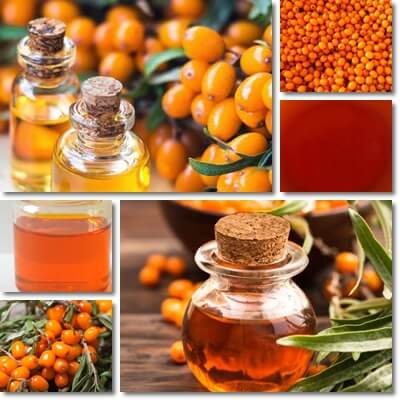Sea-buckthorn berry oil and sea-buckthorn seed oil are the two types of oil obtained from the fruit of the sea-buckthorn plant. Both types of oil are edible and can be used externally, on the skin, hair and nails, and internally, as a dietary supplement. The berry and seed oil have similar health effects and therapeutic uses. However, they are not quite the same thing. In addition to being made from different fruit parts, the two oils differ in their fatty acids composition and other properties.
Read on to find out the most relevant differences between sea-buckthorn berry and seed oil.
Difference no. 1: raw materials
The biggest difference between the two types of sea-buckthorn oil is in the name: sea-buckthorn berry oil is made exclusively from the fruit pulp or flesh while sea-buckthorn seed oil is made exclusively from the fruit seeds. Cold-pressing is a common method for extracting the naturally-occurring fats in the fruit pulp and seeds as well. However, more recently, CO2 or carbon dioxide extraction has gained momentum as the go-to method for sea-buckthorn seed oil extraction. CO2 extraction uses temperatures as low as mechanical extraction, even lower in some cases, which helps preserve the natural properties of the fats extracted, and is non-toxic.

Difference no. 2: appearance
The berry and seed oil look quite different from one another. Sea-buckthorn berry oil is darker colored, a darker orange with a brownish undertone. Whereas sea-buckthorn seed oil is lighter colored, a light to paler yellow. The difference between sea-buckthorn berry and seed oil in terms of appearance is owed to the content of naturally-occurring carotenoid antioxidants in the fruit pulp and seeds. More specifically, the fruit pulp is a lot higher in pigmented carotenoid antioxidants than the fruit seeds.
Note: sea-buckthorn fruit pulp and seeds both contain pigmented carotenoid antioxidants (orange-red carotenes and yellow xanthophylls), just in different amounts, hence the difference in color between the resulting sea-buckthorn oils.
Difference no. 3: thickness or consistency
Sea-buckthorn seed oil is liquid in consistency, like a typical oil. But the berry oil is slightly thicker or more viscous in consistency. The viscosity is more noticeable in the berry oil if it’s refrigerated or kept somewhere that is colder than normal room temperature – at lower temperatures, it will get thicker or more viscous. Together with color, thickness or consistency will help you tell the difference between sea-buckthorn berry and seed oil.
Difference no. 4: fatty acids profile and composition
The two types of sea-buckthorn oil have different fatty acids profiles and composition. Sea-buckthorn seed oil is highest in linoleic acid (a polyunsaturated Omega-6 fatty acid) and alpha-linolenic acid (ALA, a plant-based polyunsaturated Omega-3 fatty acid). One study found the proportion of linoleic and alpha-linolenic fatty acids in the seed oil to be 33–36% and up to 42%, and 30–36% and up to 39%, respectively.
Depending on the species and cultivar of sea-buckthorn, linoleic and alpha-linolenic fatty acids account for 65% to 70% of the total fatty acids content in the seed oil (study). Other fatty acids in sea-buckthorn seed oil include oleic acid (monounsaturated Omega-9) at 17%-20%, palmitic acid (a saturated fatty acid) at around 7% and palmitoleic acid (monounsaturated Omega-7) and stearic acid (saturated fatty acid) at less than 4% of total fatty acids content.
By comparison, sea-buckthorn berry oil (also called sea-buckthorn fruit or pulp oil) is made up of mostly palmitoleic acid (a monounsaturated Omega-7 fatty acid) and palmitic acid (a saturated fatty acid). According to the same study sourced above, palmitoleic acid represents 32% to 42% of the total fatty acids content in the berry oil, followed by palmitic acid at 34% to 41%.
To a lesser extent, the following fatty acids we present in the berry oil: linoleic acid (polyunsaturated Omega-6) at 8–14%, cis-vaccenic acid (unsaturated Omega-7) at 5-7%, oleic acid (monounsaturated Omega-9 also found in olive oil) at 1-5%, and alpha-linoleic acid (polyunsaturated Omega-3) and stearic acid (saturated fatty acid) at less than 2% of total fatty acids content.

And here is an interesting fact: oleic acid is a monounsaturated Omega-9 fatty acid best known as the main fat in olive oil (see what are the 7 types of olive oil by quality), but it’s also present in significant amounts in sunflower seed oil, canola oil, grape seed oil, sesame oil, chicken fat, lard and it’s one of the dominant fats in human fat tissue.
Difference no. 5: nutrient profile and composition
Here are a few of the most notable nutrition facts differences between sea-buckthorn seed and berry oil worth remembering:
- Sea-buckthorn seed oil is higher in Omega-6 (linoleic acid) and ALA Omega-3 (alpha-linolenic acid).
- Sea-buckthorn berry oil is higher in Omega-7 fatty acids (palmitoleic acid, cis-vaccenic acid).
- Sea-buckthorn berry oil is higher in saturated fats (e.g. palmitic acid content in a sea-buckthorn berry oil was found to account for 34% to 41% of total fatty acids content). Versus sea-buckthorn seed oil which has a saturated fatty acids content of up to 10% on average (e.g. palmitic acid at 7%, stearic acid at under 4%).
- Sea-buckthorn berry oil is overall higher in pigmented carotenoid antioxidants vs the seed oil. You can also tell this by the differences in color (e.g. the berry oil is a darker orange, while the seed oil is a paler yellow).
- Sea-buckthorn berry oil is higher in provitamin A. What is provitamin A? Provitamin A is the precursor form of vitamin A and consists of the following carotenoid antioxidants: beta-carotene, alpha-carotene, beta-cryptoxanthin, gamma-carotene. The body uses these 4 carotenoids to produce vitamin A from them.
- Roughly 76−89% of the total vitamin E content in sea-buckthorn berries is represented by alpha-tocopherol, vs 93−98% of the total vitamin E content in the seeds which is represented by multiple forms of vitamin E (alpha, beta, gamma and delta-tocopherol) (source). That would mean that the berry oil is higher in alpha-tocopherol, while the seed oil has better representation in terms of vitamin E profile.
Note: It is possible for sea-buckthorn oil to not be consistent and exhibit differences in the content of some vitamins, dietary minerals, antioxidants and even minor differences in fatty acids profile and composition. The raw materials, that is, the sea-buckthorn berries used for oil extraction as well as the choice of extraction method and storage conditions will determine the final nutritional properties of the oil. In general, plant species, cultivar, fruit maturity, climate, weather conditions prior to harvesting, altitude and similar factors directly impact fruit nutrition and the nutrition of subsequent by-products.
Difference no. 6: carotenoid content
It’s clear from the difference in color between the two sea-buckthorn oils that carotenoid representation differs. Sea-buckthorn berry oil, the more colorful of the two, is believed to be overall higher in carotenoid antioxidants. Which carotenoids and by how much is difficult to tell because of the variation in carotenoid content and profile of sea-buckthorn fruits according to species, cultivar, maturity of the fruit (and seeds) and any and all conditions that impact fruit (and seed) development, as well as choice of production method and more factors. Carotenoids present in the two oils include carotenes (alpha-carotene, beta-carotene, beta-cryptoxanthin, gamma-carotene, lycopene) and xanthophylls (zeaxanthin, lutein).
